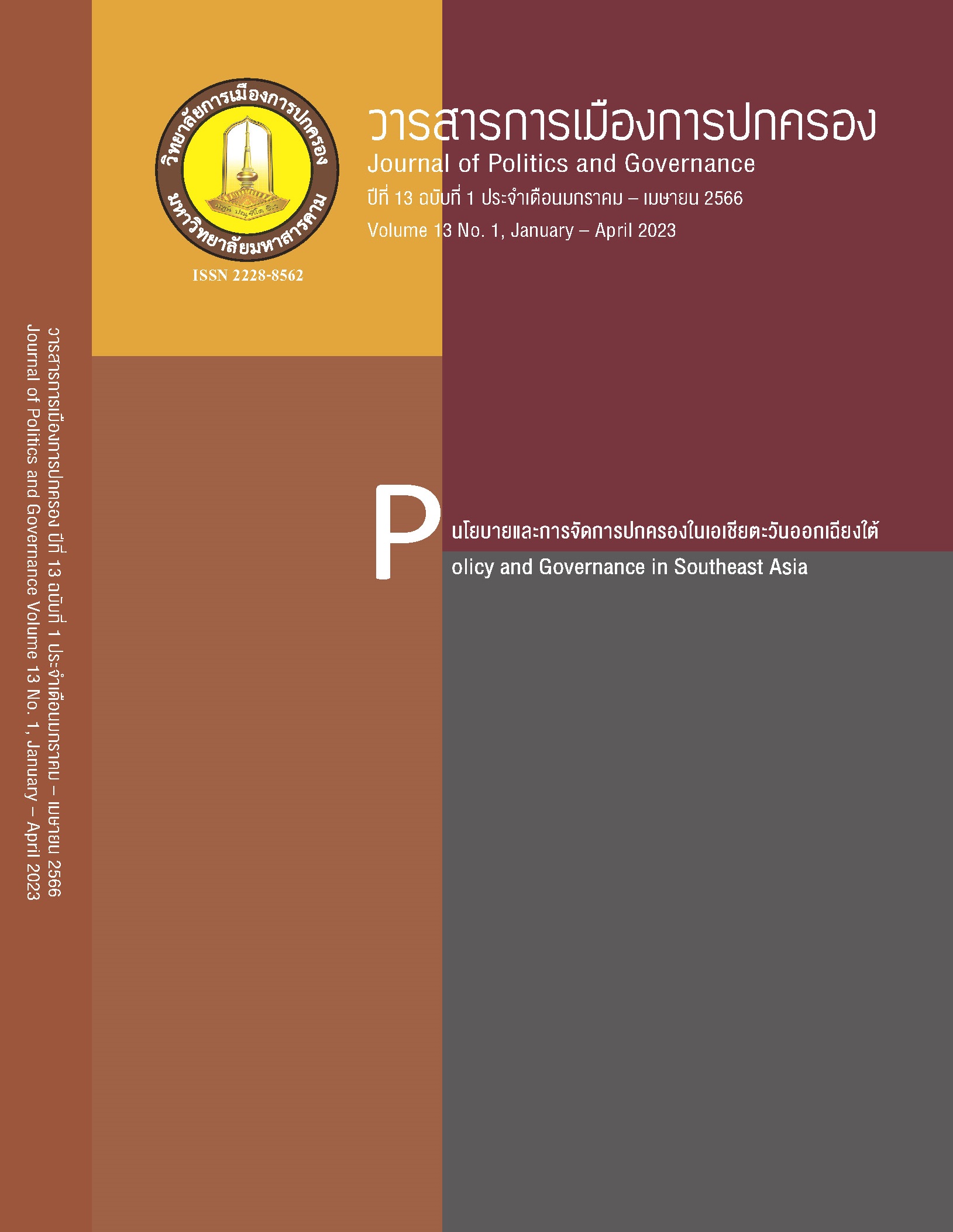Reflections on Defining and the characteristics of a Resource Dependence Theory Relating to Organizational Environment
Main Article Content
Abstract
This article reflects on the relationship between an organization and its environment and shows that Resource Dependence Theory can clearly demonstrate this relationship and its significance to an organization’s survival. Resource Dependence Theory has a complex origin and is supported by a number of underlying concepts related to power and social exchange. Foremost is the proposition that an organization relies on various resources in order to survive, the most necessary resources tend to be controlled by other organizations. Therefore, an organization must hold power and seek to acquire resources while also decreasing its dependence on other organizations. This article discusses Resource Dependence Theory in terms of Jeffrey Pfeffer and Gerald R. Salancik’s model, as theirs is widely considered the official model for this theory. In short, the theory posits that in order to understand organizational behavior, one must first understand the ecology of an organization, and the key to an organization’s survival is its capacity to acquire and maintain important resources from its environment. To acquiring needed resources by using organizational strategies and organization must transact with other elements in their environment, including the negotiating exchange.
Article Details
References
Aiken, M., & Hage, J. (1968). Organizational interdependence and intra-organizational structure. American Sociological Review, 33(6), 912–930.
Aldrich, H. E. (1979). Organizations and environments. Englewood Cliffs, N.J: Prentice-Hall.
Aldrich, H. E., & Pfeffer, J. (2002). Environments of Organizations. Annual Review of Sociology, 2(4), 79-105.
Amy J. Hillman, Michael C. Withers, Brian J. Collins. (2009). Resource Dependence Theory: A Review. Journal of management, 35(6), 1404 - 1427.
Argenti, J. (1976). Corporate collapse: The causes and symptoms. New York: McGraw Hill.
Bourdier, Pierre. (1977). Outline of a Theory of Practice. London: Cambridge.
Blau, P. M. (1964). Justice in social exchange. Sociological Inquiry, 34(2), 193-206.
Cameron, G. (1997). Protecting children and supporting families: Promising programs and organizational realities. New York: Aldine De Gruyter.
Giddens, Anthony. (1984). The Constitution of Society: Outline of the Theory of Structuration. Los Angeles : University of California Press.
Perrow, C. (1970). Organizational analysis: A sociological view. Marceline, Missouri: Wadsworth Publishing Company.
Dahl, R. A. (1957). The concept of power. Behavioral Science, 2(3), 201-215.
Drucker, P. F. (1995). Managing in a time of great change. New York: Truman Tally Book/Dutton.
Emerson, R. M. (1962). Power–Dependence Relations. American Sociological Review, 27(1), 31-41.
Etzioni, A. (1960). Two approaches to organizational analysis: A critique and a suggestion. Administrative Science Quarterly, 5(2), 257–278.
Frishammar, J. (2014). Organizational environment revisited: A conceptual review and integration. International Studies of Management & Organization, 36(3), 22-49.
Gmür, M. (2008). Co-citation analysis and the search for invisible colleges: A methodological evaluation. Scientometrics, 57(1), 27-57.
Hickson, D. J., Hinings, C. R., Lee, C. A., Schneck, R. E., & Pennings, J. M. (1971). A strategic contingencies’ theory of intraorganizational power. Administrative Science Quarterly, 16(2), 216-229.
Homans, G. C. (1958). Social behavior as exchange. American Journal of Sociology, 63(6), 597-606.
Jacobs, D. (1974). Dependency and vulnerability: An exchange approach to the control of organizations. Administrative Science Quarterly, 19(1), 45-59.
Kanter, R. M. (1979). Power failure in management circuits. Harvard Business Review, 57(4), 65-75.
Katz, D., & Kahn, R. L. (1966). The social psychology of organizations. New York: Wiley & Sons.
Kotter, J. P. (1977). Power, dependence, and effective management. Harvard Business Review, 55(4), 18-27.
Kotter, J. P. (1979). Managing external dependence. Academy of Management Review, 4(1), 87-92
Levine, S., & White, P. E. (1961). Exchange as a conceptual framework for the study of interorganizational relationships. Administrative Science Quarterly, 5(4), 583–601.
Osborn, R.N., & Hunt, J. G. (1974). Environment and organizational effectiveness. Administrative Science Quarterly, 19(2), 231-246.
Pfeffer, J. (1981). Power in organizations. Marshfield, Mass.: Pitman Pub.
Pfeffer, J., & Leong, A. (1977). Resource allocations in united funds: Examination of power and dependence. Social Forces, 55(3), 775-790.
Pfeffer, J., & Moore, W. L. (1980). Power in university budgeting: A replication and extension. Administrative Science Quarterly, 25(4), 637-653.
Pfeffer, J., & Salancik, G. R. (1978). The external control of organizations: A resource dependence perspective. New York: Harper & Row Publishers.
Quinn, R. E., & Rohrbaugh, J. (1983). A spatial model of effectiveness criteria: towards a competing values approach to organizational analysis. Management Science, 29(3), 363-377.
Salancik, G. R., & Pfeffer, J. (1974). The bases and use of power in organizational decision making: The case of a university. Administrative Science Quarterly, 19(4), 453-473.
Scott, W. R. (1977). The effectiveness of organizational effectiveness studies. In New Perspectives on Organizational Effectiveness, P. S. Goodman, & J. M. Pennings (eds.), pp. 63–95. San Francisco: Jossey-Bass
Seabright, M. A., Levinthal, D. A., & Fichman, M. (1992). Role of individual attachments in the dissolution of interorganizational relationships. Academy of Management Journal, 35(1), 122-160.
Seashore, S. E., & Yuchtman, E. (1967). Factorial analysis of organizational performance. Administrative Science Quarterly, 12(3), 377-395.
Selznick, P. (1949). TVA and the grass roots: A study in the sociology of formal organization. Berkeley and Los Angeles: University of California.
Sheppard, B. H., & Sherman, D. M. (1998). The grammars of trust: a model and general implications. The Academy of Management Review, 23(3), 422-437.
Sheppard, J. P. (1995). A resource dependence approach to organizational failure. Social Science Research, 24(1), 28-62.
Suarez, F. F., & Oliva, R. (2015). Environmental change and organizational transformation. Industrial and Corporate Change, 14(6), 1017-1041.
Thompson, J. D. (1967). Organizations in action: Social science bases of administrative theory. McGraw-Hill.
Tilles, S. (1963). The manager's job: a systems approach, Harvard Business Review, 41(1), 73-81.
Ulrich, D., & Barney, J.B. (1984). Perspectives in organizations: Resource dependence, efficiency, and population. Academy of Management Review, 9(3), 471-81.
Weber, M. (1947). The theory of social and economic organization. Translated by A. M. Henderson and Talcott Parsons. New York: Oxford University Press.


